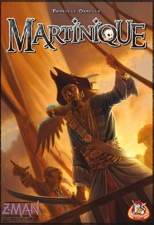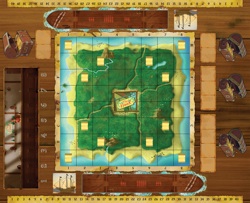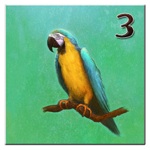
|
About OgreCave and its staff
|

|
by Allan "Sven" Sugarbaker
Pirate-themed games are somewhat common in the tabletop gaming realm, as are treasure hunt games. But rarely do said games cut to the chase and immediately start digging for buried treasure, gathering goods from the very start. Rarely does such a game have strategic elements that are easy to grasp, while still maintaining just enough theme to help players stay invested in the gameplay. Martinique manages all this, and is quick playing, too. In Martinique, each player takes on the role of a pirate captain, searching for the "Lost Treasure" – the big score, the treasure trove whispered of in legends. To find it, each captain commands four pirates that search the island of Martinique for clues to its location, picking up other trinkets along the way. At the game's end, if a player guesses the location of the Lost Treasure, he wins; if not, players count up points scored by gathering trinkets, and the highest score wins.
Thar Be Treasure
Maneuvering is especially important when it comes to Map tiles. Prior to placing any Map tiles on the Martinique board, they are sorted into numbers and letters, and one of each is randomly placed in the Lost Treasure spot next to the island. Determining the treasure's location is the game's primary goal, and much like Clue or other investigation board games, this is done through the process of elimination: if you uncover a Map tile, you know the Lost Treasure isn't buried in that row or column. Obviously, claiming Map tiles before your opponent is extremely important, and if one player grabs a majority, it could be a huge advantage. The pirates are sneaky fellows, though, and are able to permanently reveal one of the opposing crew's Map tiles each time a pirate token moves through a space occupied by an enemy token.
On either side of the board is a pirate ship, one for each player. If
you think these long vessels would be the perfect place to put treasure
claimed on the island, you're right. But not so fast – your crew can't
just throw whatever they gather into the ship's hold. Instead, players
use their pirates to gather certain combinations of Souvenir tiles and
match them to randomly selected Small Treasure sets of 2, 3, and 4
tiles, respectively. Displayed along the fourth side of the board, these
sets are worth points to the player that collects them, and are randomly
reselected each time a set is scored. These Small Treasure sets get
placed in the ship's hold, kept together as a set, and may help the
player win if no one finds the Lost Treasure. If a pirate token ever lands on an empty space, whether by accident or choice, the lazy pirate gives up searching the island and retires to the next unoccupied seat at the bar. While going to The Hook removes a pirate token from the treasure hunt, a timely arrival at the bar can be well worth it. Remember the two Map tiles and three Joker tiles placed in the bar during setup? Those are up for grabs – first come, first served. Joker tiles can be useful to score Small Treasure sets, as they act as wild card Souvenir tiles.
If neither player guessed the Lost Treasure's location, it comes down to
which one got the most points. For each Small Treasure pile loaded into
a player's hold, he scores 2 points. Each Souvenir tile that was part of
a Small Treasure also provides the player with points equal to the
number on the tile. Finally, every set of two duplicate Souvenir tiles
left in what the player claimed grants him 2 points. Each side of the
board has a scoring track to make final count-up easier. If the players
tie, the winner is the player that scored the most Small Treasure piles.
If the number of piles is also tied, no one wins.
Choosing a Course Some of the most amusing sessions of Martinique came about when one of us failed to get a strong sense of where the Lost Treasure was hidden. It then became a cat-and-mouse process of watching where the other player placed his first guess, and placing a few guesses nearby. Not the best plan, of course, but it might work...
Conclusions Links:
|
||||
 Martinique (2010)
Martinique (2010) Each player controls a crew of four pirates, at least three of which
must be placed around the island on shore spaces before that crew can
begin exploring. To move, a pirate simply looks at the Souvenir or Map
tile he's standing on for a number (1, 2, or 3) and moves that many
orthogonal spaces. The player then removes the tile just vacated,
leaving an empty space. Since the island is covered with tiles – the
face-up Souvenir tiles and the Map tiles – and every tile displays a
movement number, players can plan their move to both gather the most
useful tiles and outmaneuver the opposing crew.
Each player controls a crew of four pirates, at least three of which
must be placed around the island on shore spaces before that crew can
begin exploring. To move, a pirate simply looks at the Souvenir or Map
tile he's standing on for a number (1, 2, or 3) and moves that many
orthogonal spaces. The player then removes the tile just vacated,
leaving an empty space. Since the island is covered with tiles – the
face-up Souvenir tiles and the Map tiles – and every tile displays a
movement number, players can plan their move to both gather the most
useful tiles and outmaneuver the opposing crew.
 Grabbing these extra tiles at the bar can be helpful, but the most
significant reason to retire to the bar early is to claim the first
stool. At the end of the game, when all the pirate tokens have run out
of places to move and end up at The Hook, the players begin guessing the
coordinates of the Lost Treasure. The first guess goes to the player
whose pirate token is on stool #1, the second guess to the player on
stool #2, and so on. Each space can only be guessed one time, making the
first few guesses extremely important. Once both players have taken
their pirate tokens from the bar, made their guesses, and placed them on
the island coordinates they believe the Lost Treasure to be at, the
location of the Lost Treasure is revealed. If either player guessed it
correctly, that player is the winner.
Grabbing these extra tiles at the bar can be helpful, but the most
significant reason to retire to the bar early is to claim the first
stool. At the end of the game, when all the pirate tokens have run out
of places to move and end up at The Hook, the players begin guessing the
coordinates of the Lost Treasure. The first guess goes to the player
whose pirate token is on stool #1, the second guess to the player on
stool #2, and so on. Each space can only be guessed one time, making the
first few guesses extremely important. Once both players have taken
their pirate tokens from the bar, made their guesses, and placed them on
the island coordinates they believe the Lost Treasure to be at, the
location of the Lost Treasure is revealed. If either player guessed it
correctly, that player is the winner.